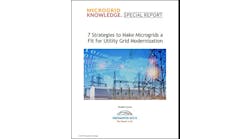Opportunity zones, created in the US as part of the 2017 Tax Cut and Jobs Act, are making a splash among green energy and microgrid investors.
“Opportunity zones create tax incentives for investors in real estate, businesses and assets in areas that might not otherwise draw investment,” says John Beidle, chief executive of New Energy Opportunities, in an interview with Microgrid Knowledge. “The further stacking of tax incentives in these areas for microgrid facilities is really a once in a lifetime opportunity especially if new employment is brought into these areas. Hopefully, the energy tax credits get extended to more fully coincide with the opportunity zone lifetime.”
The investment tax credit, or Section 48, allows project owners or investors to be eligible for federal business energy investment tax credits for installing designated renewable energy equipment placed in service from 2006 through 2024. Fuel cells were added in 2018.
Here’s how opportunity zones work: Localities qualify as zones if the states select them and that nomination is subsequently affirmed by the US Treasury. Governors are permitted to designate up to 25% of low-income areas as opportunity zones. Those zones are now in all 50 states — an economic development tool created to spur jobs in distressed areas by providing tax benefits to investors. Those risk takers get a capital gains break if they invest in these economically-distressed regions.
Opportunity zones as social tool
To be sure, opportunity zones have critics, who say that the investors come out better than the residents of distressed communities. But their proponents counter that such incentives are necessary to entice development. And microgrids, too, are economic development tools, thus creating a “compounding effect.” That dynamic refers to stacking tax credits on top of one another, which can reduces the taxes owed or make the microgrid equipment more affordable.
As the Economic Innovation Group (EIG) explained in testimony before Congress, the money can be used to fund an array of equity investments in a variety of different sectors, including microgrids. And the incentives are also scalable because there is no cap on the amount that can be invested.
An EIG’s analysis estimates $6.1 trillion in unrealized capital gains held by US households and corporations as of the end of 2017. “Even a small fraction of these gains reinvested into opportunity zones would make it the largest economic development initiative in the country,” says John Lettieri, founder of the group, in congressional testimony.
Those funds should help “communities tackle a wide range of issues, including revitalizing downtown districts, boosting local entrepreneurship, establishing specialized funds to target rural development challenges, commercializing technology around local knowledge centers, and more,” he continues.
Ideal for microgrids
M Property Services, for example, is a land developer in the Midwest. It has properties in the opportunity zone. Paul McKee, chief executive of the company, told Microgrid Knowledge that the opportunity zones are the missing link when it comes to financing commercial projects and microgrids: “Opportunity zones are perfect for microgrid because they bring equity and because of their social impact.”
Consider also FuelCell Energy, which is able to concentrate carbon dioxide from dilute flue gas streams as a side reaction during power generation: The concentrated carbon is then available for sequestration or utilization, which can be used in coordination with microgrids.
“The Department of Energy invests a lot of money in new technologies that may never become viable businesses or business processes,” says Beidle, with New Energy Opportunities. “Using a fuel cell for carbon capture is proven technology they have already funded.
“All capital gains are also eligible for this program,” all of which should encourage microgrid development, he adds.
Opportunity zones could become a valuable funding vehicle for microgrid projects. And investors would be wise to give them a close examination.
Track news about microgrid funding opportunities. Subscribe to the free Microgrid Knowledge newsletter.








